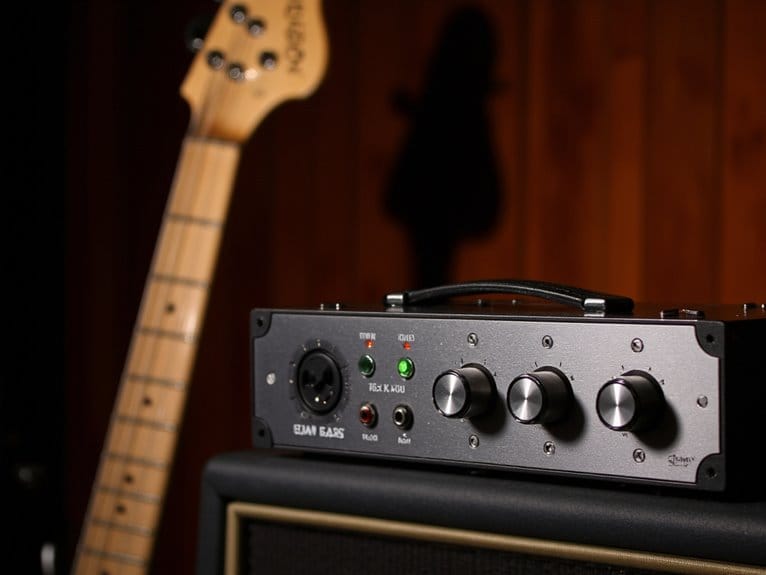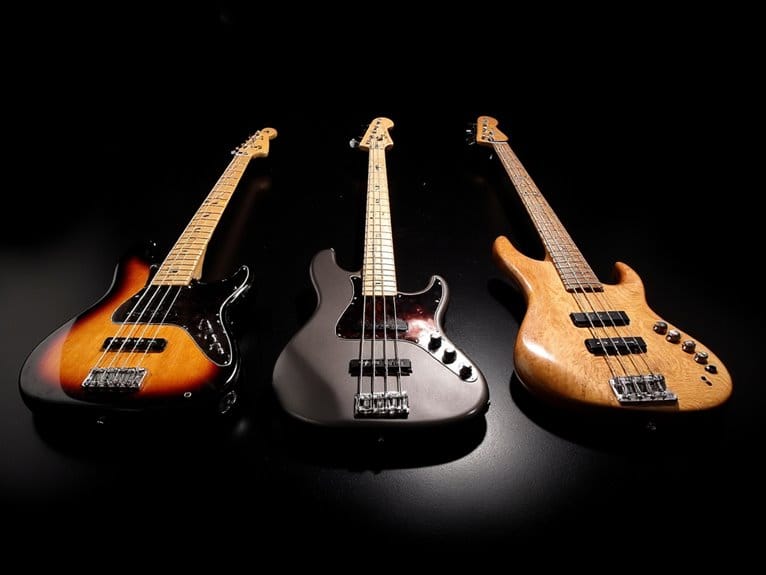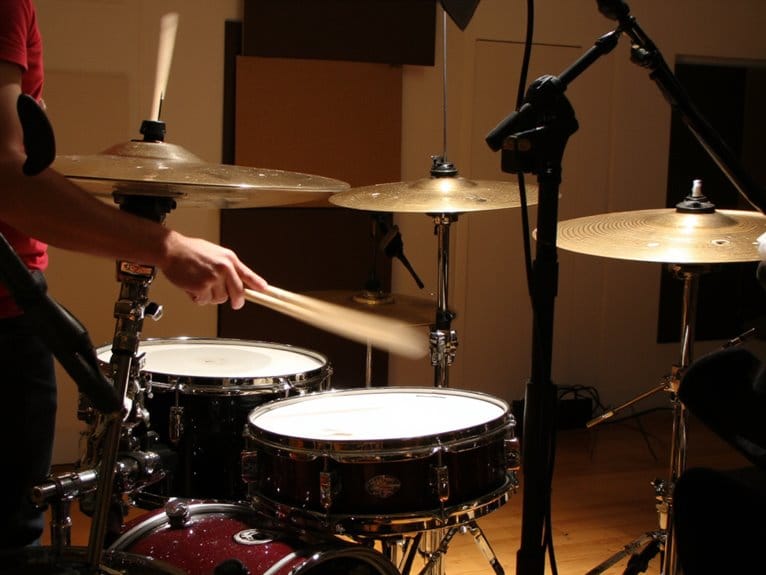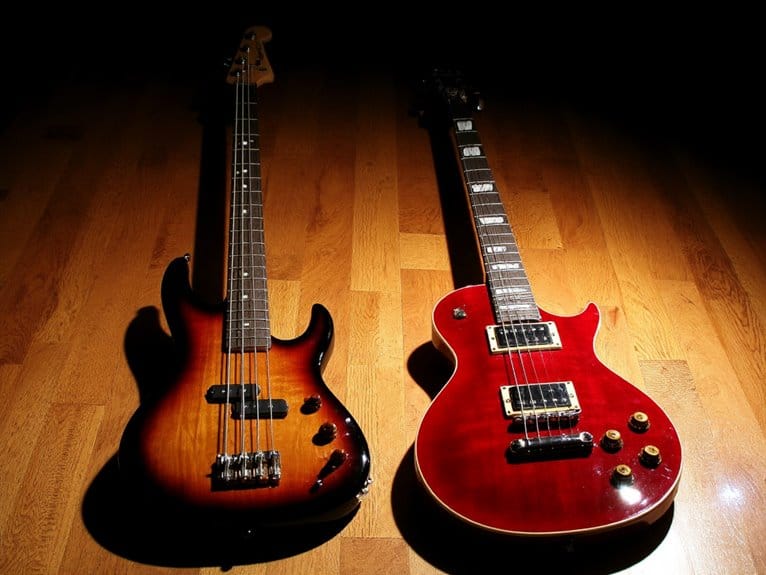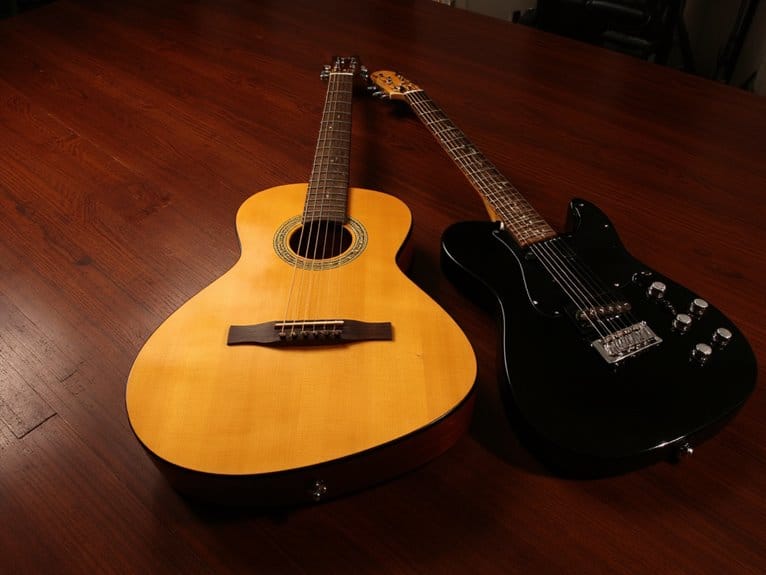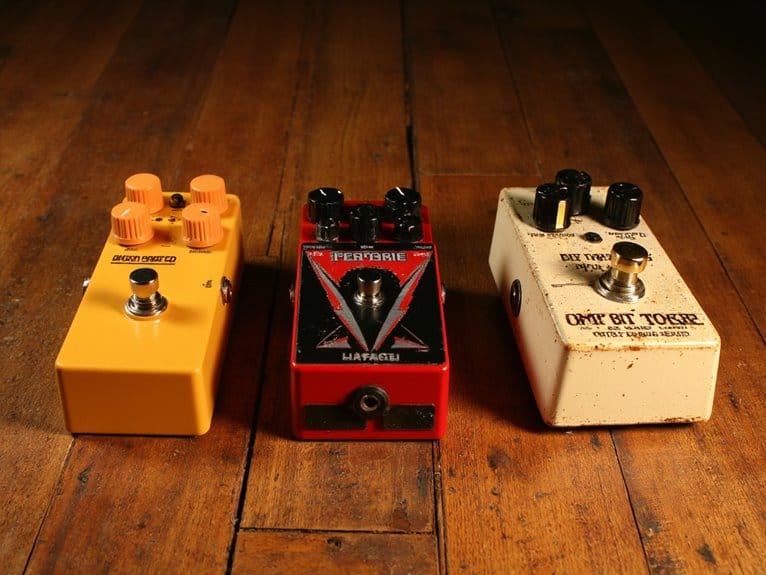Understanding Bass Guitar Preamps and Their Role
Bass guitar preamps serve as essential signal processors that boost your pickup’s weak output to line level while providing extensive tone shaping through 3-band EQ controls. They’re compact alternatives to full amplifier stacks, offering direct connections to PA systems and audio interfaces with integrated DI outputs that reduce noise. Whether you’re using passive or active basses, proper impedance matching guarantees peak performance in both live venues and studio environments, and understanding their advanced features reveals even greater tonal possibilities.
We are supported by our audience. When you purchase through links on our site, we may earn an affiliate commission, at no extra cost for you. Learn more.
Notable Insights
- Bass guitar preamps boost weak pickup signals to line level while providing essential tone shaping through adjustable EQ controls.
- They offer compact alternatives to full amplifier stacks with direct PA system connectivity and integrated DI outputs.
- Proper input matching between passive/active basses and preamp inputs prevents noise and maintains optimal signal quality.
- Preamps deliver consistent tone to sound engineers and enhance recordings by warming signals before audio interfaces.
- Key features include gain control, 3-band EQ systems, and advanced models with sweepable midrange and parametric options.
What Bass Guitar Preamps Do and Why You Need Them
When I first started playing bass seriously, I’ll admit I didn’t fully grasp why anyone would need a preamp pedal when most bass amps already have built-in preamps.
However, after years of gigging and studio work, I’ve discovered that bass preamp pedals offer incredible pedal advantages that traditional amps simply can’t match. They serve as compact alternatives to full amplifier stacks, allowing you to connect directly to PA systems or audio interfaces without needing bulky equipment.
The DI integration capabilities provide balanced outputs that reduce noise and interference over long cable runs, while also optimizing signal levels for both passive and active pickups. These pedals essentially replicate the preamp section of a bass amplifier while maintaining the portability and convenience that modern bassists demand.
You’ll find they’re essential for silent practice, streamlined live setups, and consistent tone shaping across different venues and recording environments. They excel at ampless gigging, eliminating the need to transport heavy amplifiers while still delivering professional-quality sound to mixing desks. Many preamps also include 3-band EQ systems that provide comprehensive tone control including midrange adjustments for precise sound sculpting.
Professional bassists particularly benefit from the dual-channel preamp capabilities that allow switching between clean tones and aggressive distortion without requiring multiple pieces of equipment.
Signal Boosting and Tone Shaping Capabilities
Beyond the practical benefits of streamlined setups and DI capabilities, the real magic happens when you start exploring what preamps can do to your actual sound. When your bass guitar’s weak pickup signal gets elevated to line level, you’re not just getting more volume—you’re preserving signal clarity that would otherwise deteriorate through long cable runs or multiple effects.
The adjustable EQ controls, typically featuring bass, midrange, and treble bands with sweepable midrange frequencies, let you sculpt your tonal balance precisely without relying solely on your amplifier’s tone stack. Whether you’re adding low-mid warmth for jazz or cutting through dense rock mixes, controlled gain adjustment prevents signal degradation while maintaining sonic integrity across your entire signal chain. This enhanced processing particularly benefits vintage passive bass guitars, which often require additional signal strength to reach their full sonic potential.
Input Options for Passive and Active Bass Guitars
While all this signal processing capability sounds impressive, there’s one essential detail that’ll make or break your preamp experience: matching your bass guitar’s output type to the correct input on your preamp.
Passive basses generate weaker signals that require dedicated passive inputs with proper impedance matching to boost your signal to usable levels without introducing noise or tone loss.
Active basses, equipped with battery-powered onboard preamps, produce higher input output levels that need attenuated active inputs to prevent clipping and distortion.
Using the wrong input connection creates volume imbalances, tonal inconsistencies, and potential signal degradation that’ll leave you wondering why your expensive gear sounds mediocre.
Modern preamps often feature switchable or automatic detection systems, eliminating guesswork and ensuring ideal impedance matching regardless of your bass type. Improper compatibility between your bass and preamp can lead to performance issues that compromise your overall sound quality.
Whether you’re using a budget-friendly P/J pickup configuration bass or a high-end instrument, understanding your bass’s output characteristics will help you select the appropriate preamp input for optimal signal processing. Quality instrument cables with proper shielding ensure your signal reaches the preamp without interference or noise contamination.
Live Performance and Studio Applications
Whether you’re tracking in a professional studio or commanding the stage at your local venue, bass preamps transform from simple signal processors into essential tone-shaping tools that bridge the gap between your instrument and the final sound your audience hears.
In live sound environments, acoustic variations between rooms can wreak havoc on your carefully crafted tone, but preamps maintain consistency by delivering your signature sound directly to front-of-house engineers before unwanted alterations occur.
Here’s how preamps excel in both settings:
- Live Performance: Send EQ-shaped signals to FOH while compensating for venue acoustics and amp differences.
- Studio Recording: Add warmth, punch, and articulation before hitting your interface, eliminating flat direct-input recordings.
- Signal Management: Combine preamp tone shaping with DI functionality for ideal signal strength and noise reduction.
- Versatile Monitoring: Use headphone outputs for silent practice or soundcheck preparation.
Many modern preamps incorporate active electronics that deliver higher output levels and superior noise reduction compared to passive systems, making them particularly valuable for cutting through dense mixes in both live and studio environments.
When recording bass in professional studios, pairing your preamp with audio interfaces that feature ultra-low latency capabilities ensures tight timing and eliminates the delay that can throw off your performance during tracking sessions. Essential accessories like boom arms can improve microphone positioning when recording both your bass amp and any accompanying vocals during performance sessions.
Key Features and Control Functions
The magic happens when you understand what’s actually under the hood of your preamp, and frankly, most players barely scratch the surface of what these controls can accomplish for their sound.
Your gain control sits at the front of the signal chain, boosting that weak pickup signal to usable line level while preventing distortion through proper staging.
The EQ versatility comes through bass, midrange, and treble controls, with advanced units offering sweepable mids and parametric options for surgical frequency selection.
Control layouts typically feature intuitive knob arrangements alongside switches for engaging EQ sections, selecting passive or active inputs, and managing output routing to DI connections or power amps for maximum flexibility.
Frequently Asked Questions
What’s the Difference Between Analog and Digital Bass Preamp Pedals?
You’ll notice analog preamps deliver warmer, more natural tones with harmonic richness, while digital ones offer crystal-clear accuracy with extensive modeling options. Analog provides that coveted warmth; digital gives you versatile clarity and features.
How Do I Properly Set Gain Staging With a Bass Preamp?
Start with input gain down, then gradually increase while playing dynamically until peaks hit 0dB. Set output to unity gain. Proper gain structure maintains ideal input levels throughout your signal chain, preventing distortion and noise.
On a final note
You’ll find that a quality bass preamp serves as the essential bridge between your instrument’s raw signal and your desired tone, whether you’re playing through a simple practice amp or a professional studio setup. I’ve consistently observed that players who invest in understanding their preamp’s capabilities, from basic EQ adjustments to advanced input matching, inevitably develop more refined control over their sound and gain confidence in both live and recording environments.

